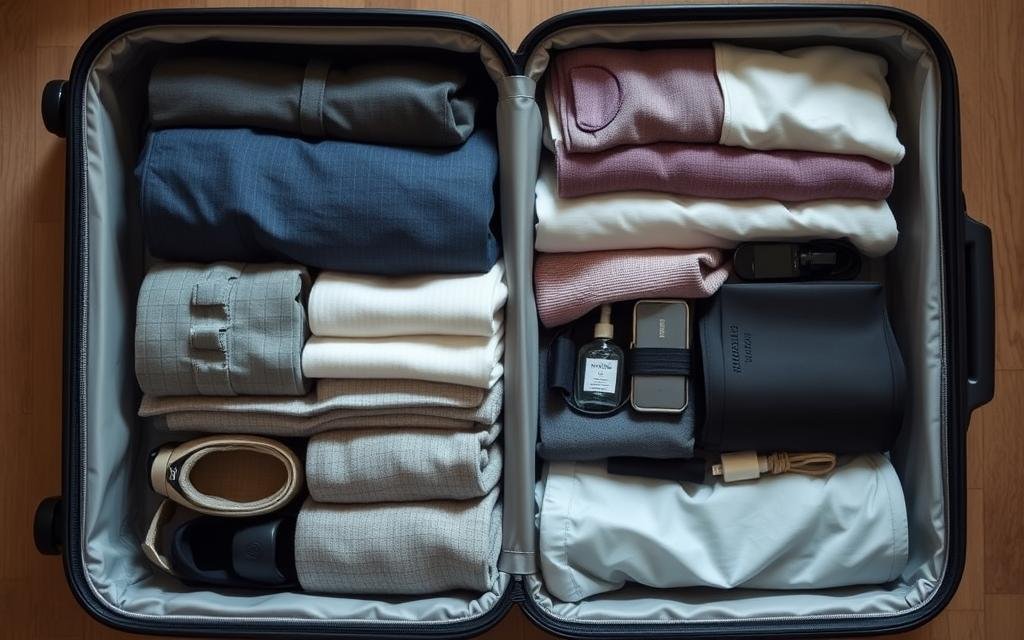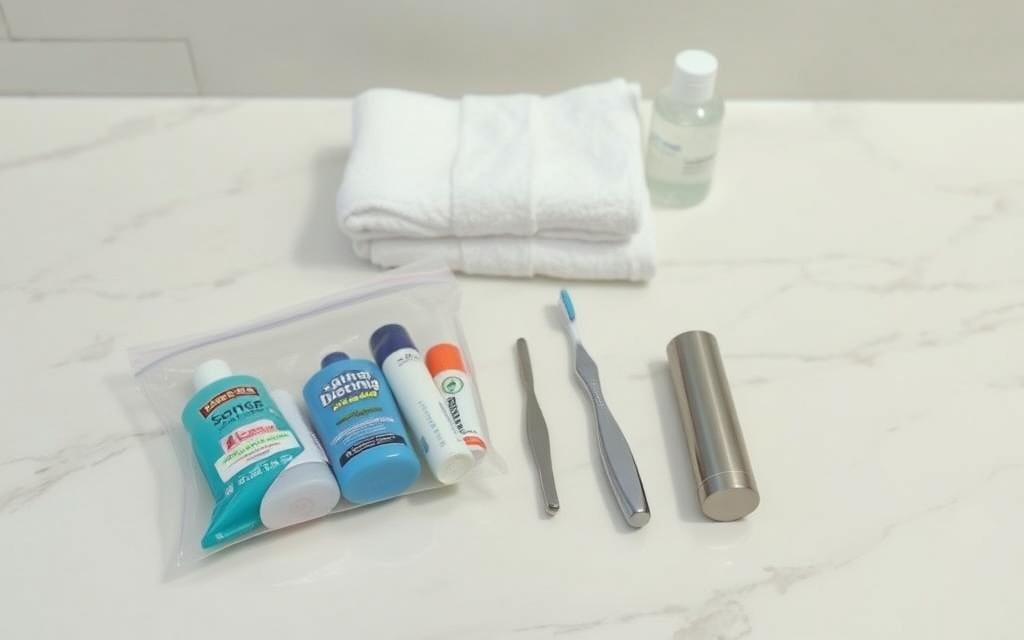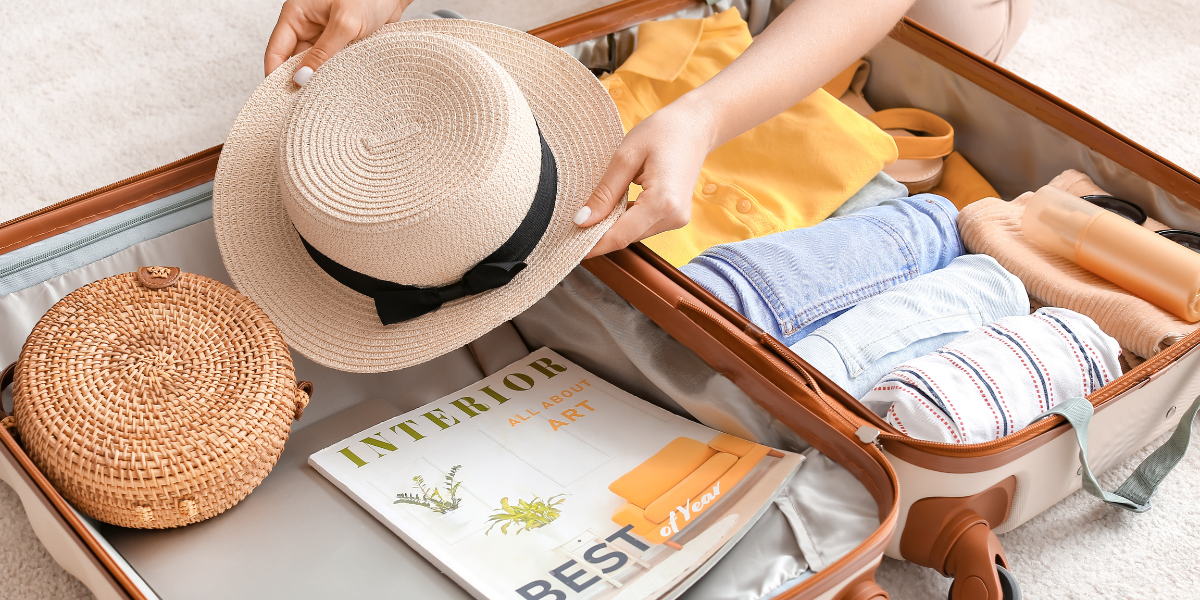Packing for a trip can feel overwhelming, but it doesn’t have to be stressful. By following expert tips, you can make packing organized and efficient, allowing you to focus on the excitement of your trip.
Whether it’s a short weekend getaway or a long international trip, these tips will help. Learn to roll clothes to save space and reduce wrinkles. Use packing cubes to organize your items. Choose the right luggage for your needs.
Key Takeaways
- Use packing cubes to organize clothes and maximize space in your luggage.
- Roll bulky items like sweaters to save space and reduce wrinkles.
- Fold blazers and dress shirts to keep them wrinkle-free during travel.
- Keep 10% of your luggage empty to accommodate purchases or additional items.
- Plan your outfits and create a packing list to avoid overpacking.
- Select luggage that fits your airline’s policy and trip type.
- Pack essentials and a spare outfit in your carry-on.
Evaluate Your Travel Needs
Understanding your travel needs is key to good travel planning and packing. Think about your destination, the weather, and how long you’ll be away. This will help you pack only what you need and keep your luggage light.
Consider Your Destination
First, think about where you’re going. Different places need different things. For example, a beach trip means swimwear and sunscreen, while mountains call for hiking boots and warm clothes. Plan your activities to know what to pack.
Account for Weather Conditions
Weather is a significant factor in what to pack. Check the weather at your destination. Packing for Miami in summer is different from Alaska in winter. Choose easy-to-wear clothes and use plastic bags to protect your clothes from wrinkles.
Duration of Your Trip
The length of the trip affects how much to pack. A short trip might need just a carry-on, but a longer one might require more space. Use packing cubes to stay organized and pack smart. If you’re traveling with someone, pack half your stuff in each bag to avoid lost luggage issues.
Make a Packing List
Creating a detailed packing list can make your trip prep easier. It helps you remember essential items like passports and documents. Planning lets you pack only what you need, avoiding overpacking. This guide provides tips and a checklist to help you stay organized.
Essential Items to Include
Consider the four W’s when making your list: where, what, who, and when. These help you pack right for your trip. Here are some must-haves:
- Passport and ID
- Travel-sized toiletries
- Medications and first aid kit
- Camera and batteries
- Chargers for all electronics
- Reusable water bottle
- Shoe bags
- Linen laundry bag
- Paravel Aviator Carry-On
Items to Leave Behind
It’s tempting to pack for everything, but less is better. Here are things you can skip:
- Too much clothing – Stick to versatile outfits
- Unnecessary duplicates – Cut down on electronics and toiletries
- Heavy books – Use an e-reader instead
- Jewelry – Keep it simple to avoid loss or damage
Categorizing Your List
Organize your list by categories to pack more efficiently. Use packing cubes for each category to stay organized:
| Category | Items |
|---|---|
| Clothing | Pants, Shirts, Dresses, Underwear |
| Toiletries | Toothbrush, Toothpaste, Shampoo, Conditioner |
| Electronics | Phone, Camera, Chargers, Power Bank |
| Miscellaneous | Snacks, Travel Pillow, Umbrella, Sunglasses |
Choose the Right Luggage
Choosing the right luggage is key to a smooth trip. Consider the types of luggage, size and weight limits, and essential features. This will help you pick the best luggage for your journey.
Types of Luggage
It’s essential to decide between hard-shell and soft-sided luggage. Hard-shell suitcases are rigid and keep things dry but have few pockets. Soft-sided suitcases have lots of pockets and can expand to hold more.
Size and Weight Considerations
To avoid extra fees, follow airline rules on luggage size and weight. Non-wheeled bags should weigh 2-4 pounds, and wheeled ones no more than 7.5 pounds. Light luggage lets you carry more.
Knowing the limits helps you pack smart. Hard-shell luggage has quiet, stable wheels, while soft-sided luggage can expand to hold more because it’s flexible.
Features to Look For
Look for luggage with features that make travel easier. It should have special pockets for laptops, packing cubes, suiter compartments, and expandable sides. Innovative features like digital scales, location tracking, and charging spots are also great.
Expandable hard-shell suitcases can hold more but might not fit in overhead bins when expanded.
- Materials: Polypropylene, polycarbonate, ABS plastic, polyester, or nylon.
- Pockets and Compartments: Look for more external and internal pockets for organized travel.
- Wheels: Hard-shell luggage usually has quieter and more stable wheels.
- Innovative Features: Digital scales, location tracking, charging compartments.
Utilize Packing Cubes
Packing cubes change how we pack by making it easier to organize our stuff. They save time and help you pack more in less space. Here are the main benefits and tips for packing cubes to tidy your suitcase.
Benefits of Packing Cubes
Packing cubes bring many advantages for organizing your suitcase:
- Space Efficiency: They help you pack more in less space.
- Easy Access: You can find what you need quickly without messing up your suitcase.
- Stress Reduction: Packing and unpacking are less stressful with everything in its place.
- Separation of Items: Use them to keep clothes, shoes, chargers, and cameras separate.
- Eagle Creek Pack-It Isolate Compression Cubes: Made from recycled fabric, water-resistant, and compresses items well.
- Yeti Crossroads Packing Cubes: Durable, three-year warranty, available in three sizes, and easy to clean.
- Patagonia Black Hole Cube: 14-liter capacity, clamshell design with mesh and taffeta for separating clothes.
How to Organize with Packing Cubes
Using packing cubes smartly involves a few key steps:
- Sort and Categorize: Use different sizes for tops, bottoms, and socks. This keeps things organized and easy to find.
- Fold and Compact: Fold clothes small and pack them upright in cubes. This saves space and makes things visible.
- Specialized Uses: Use cubes for specific things like daily outfits or special events. This makes transferring items easier.
- Avoid Overstuffing: Don’t pack too much in cubes. This keeps things organized and easy to access.
- Transparency: Clear cubes let you see what’s inside without opening them. This makes packing faster.
Start using packing cubes to change your packing experience. These innovative strategies make your suitcase organization efficient and effective.
Roll vs. Fold: The Packing Debate
Travelers continue to debate rolling vs. folding clothes. Knowing when to use each method can save space and keep clothes wrinkle-free.
Rolling Clothes
Many travelers prefer rolling clothes for their space-saving benefits and wrinkle-reducing qualities. Roll knitted tops tightly to minimize wrinkles. The Ranger Roll technique saves space, fitting up to 11 t-shirts and two sweaters in one piece.
Folding Clothes
Folding clothes are classic and perfect for woven fabrics like pants and dresses. Folding pants in thirds helps fit longer legs without bulk. It’s also good with packing cubes and folders for neat organization.
When to Combine Techniques
The best approach is to use both rolling and folding. Roll delicate items to keep them wrinkle-free, and fold bulkier items for better organization. This way, you can pack more efficiently and keep your clothes in great shape.
| Technique | Best for | Benefits |
|---|---|---|
| Rolling | Knitted tops, t-shirts, delicate items | Minimizes wrinkles, maximizes space on top, fits more items |
| Folding | Pants, skirts, dresses, woven fabrics | Keeps items structured, organizes neatly, prevents overfilling |
| Combination | All types of garments | Optimizes space and organization, versatile use |
Maximize Space in Your Luggage
Efficient packing can significantly improve your travel. Compression bags and smart packing can save space, allowing you to carry more of what you need and find.
Compression Bags
Compression bags are a big help in packing clothes. They remove air, making your clothes take up less space. This is great for bulky items like sweaters and jackets.
Filling Gaps with Small Items
Every inch of your luggage counts. Use small items like socks and accessories to fill gaps. Also, put toiletries and other small items in bright spots to save space.

These packing tips can help you pack more efficiently, making your travel more organized and less stressful.
Be Smart About Clothing Choices
Choosing the right clothes is key to a great travel experience. By picking outfits that can be mixed and matched, you can pack light and stylishly. Layering your clothes is also brilliant, as it lets you adjust to changing weather and events while saving space in your luggage.
Versatile Outfits
Packing light is more straightforward, and versatile outfits can be worn many times. Neutral colors like black, navy, and khaki are great because they accompany many other clothes. Look for clothes that can do double duty, like lightweight shorts that can be swim trunks.
Choose durable clothes from ExOfficio, TravelSmith, Tilley, Eddie Bauer, and REI brands. They offer both style and function. When packing, test wash your clothes to see if they can be hand-washed well. Pick fabrics that don’t wrinkle easily or look good when they do.
Also, pack versatile accessories like scarves. They can add style to your outfit or help you stay warm or modest.
Layering for Various Weather
Layering is a smart way to handle different weather without carrying too much: layer lightweight jackets, sweaters, and cardigans over shirts and tops. Choose quick-dry fabrics and comfy shoes for a better travel experience.
For places like southern Europe, pack knee-length skirts or Capri pants. A lightweight shirt or scarf can also help with dress codes at religious sites. By picking versatile clothes and layering, you’re ready for anything while keeping your luggage light.
| Versatile Wardrobe Tips | Advantages |
|---|---|
| Neutral Color Scheme | Easy to mix and match outfits |
| Quick-Dry Fabrics | Easy maintenance and comfort |
| Layering Technique | Adaptability to weather changes |
| Wrinkle-Resistant Fabrics | Polished appearance without ironing |
Toiletries: What to Pack
Packing the proper toiletries for your trip is key. You need to pick travel-sized items and know the airline rules. Following TSA guidelines and packing the essentials will make your journey better.
Travel-Sized Products
Choosing travel-sized toiletries is essential for airline rules. Miniature versions of shampoo, conditioner, and makeup are available. Make sure these items are under 3.4 ounces, as per TSA rules.

- Mini razor and shaving cream
- Portable hairdryer and curling iron
- Sunscreen
- Hand sanitizer spray or wipes
- Lip balm
- Travel-sized lotion, face wash, and moisturizer
- Medications and pain relievers
Essential Toiletry Must-Haves
Think about items that can do more than one thing to save space. Here are some must-haves:
- First aid kit items like band-aids and blister plasters
- Underarm deodorant wipes
- Mini lint roller and Tide To Go
- Bug spray and wipes
- Fashion tape for wardrobe malfunctions
- Poo-Pourri spray for emergency use
To stay organized, use a hanging toiletry bag with lots of pockets. It should also be water-resistant. Travelpro offers TSA-compliant bags with hangers for easy bathroom setup.
Compliance with Airline Regulations
Following airline rules can save you trouble at security. Stick to the TSA 3-1-1 rule: 3.4-ounce containers in one clear bag. Travelpro’s Essentials™ Split Case is a good choice.
Here is a helpful comparison of recommended travel bags:
| Feature | Recommended Bag |
|---|---|
| Water-resistant | Travelpro’s Essentials™ Split Case |
| Multiple Compartments | Travelpro’s Essentials™ Split Case |
| TSA-compliant | Travelpro’s Essentials™ Split Case |
Using reusable, travel-sized containers is good for the planet and follows the rules. It makes traveling more straightforward and more efficient.
Keep Important Documents Handy
Traveling can be stressful if you can’t find your important documents. Having both physical and digital copies of these documents can help a lot. Here’s how to keep your travel info safe and organized.
Organizing Travel Documents
Dig your travel documents into passports, visas, and travel insurance categories. Store these in a fireproof file box at home. Use a travel organizer with sections for each type of document for your trip.
Make it a routine to check and update your documents yearly. This ensures they are current and valuable.
Digital Copies of Important Documents
Creating digital copies of your documents is key. To store your documents safely, use cloud storage, virtual safe deposit boxes, USB drives, and online password managers. These methods make your documents easy to access and secure.
Store cash, spare keys, and emergency contacts in your secure container for extra safety. Organize your documents into piles like action, household, or archive. This helps keep everything in order.
| Method | Benefits |
|---|---|
| Cloud Storage | Easy access from anywhere, backed up by cloud providers. |
| USB Flash Drives | Portable and convenient, it can be encrypted for security. |
| Virtual Safe Deposit Boxes | High security; protection against physical damage like fire. |
| Online Password Managers | Secure and encrypted, it can also store other important info. |
Prepare for the Unexpected
Traveling can be full of surprises. It’s wise to be ready for anything. A ‘just in case’ kit can help with delays, emergencies, or hunger. Anticipating problems keeps your trip smooth and fun.
Packing a ‘Just in Case’ Kit
A ‘just in case’ kit is vital for unexpected needs. Include a spare outfit, toiletries, and medications in your carry-on. A small first aid kit with band-aids, wipes, and pain relievers is essential.
Don’t forget essential documents like your passport and credit cards. Make copies and keep them safe. Also, carry some emergency cash and a spare credit card for financial surprises.
Keeping Snacks and Entertainment Accessible
Keep snacks and fun things within reach for delays. A collapsible day pack is handy for quick trips or when you can’t find your luggage. Pack snacks like granola bars or nuts for energy.
Bring books, tablets, or games to fight boredom during long waits. These travel tips help you stay ready for anything. Remember to pack a headlamp and extra medications for a worry-free trip.

